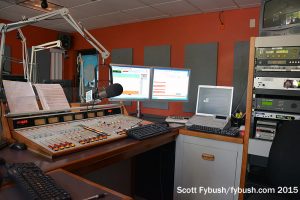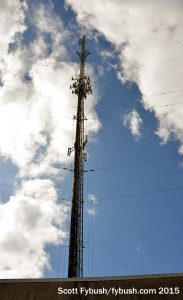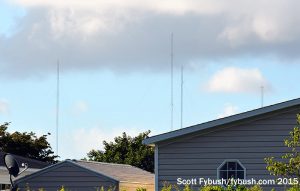NorthEast Radio Watch 12/15/2025: NYC Morning Shakeup
In this week’s issue… NYC morning shows exit - Carton back amidst WFAN shakeup - FM signing off in Canada - More radio centennials
Text and photos by SCOTT FYBUSH
Want to see some West Palm Beach radio studios? We did – and these days, that’s basically one of two big commercial clusters and a third upstart that’s competing with them. Digity’s Palm Beach Broadcasting (which is in the process of becoming part of Alpha Media) is one, and iHeart is the other – and they’re both located in close proximity just north of downtown West Palm Beach.

The iHeart cluster is in a low-slung building in an office park in Mangonia Park, just off I-95, and it’s here that we find news-talk WJNO (1290), its sister station WBZT (1230), Spanish hits WRLX (92.1), hot talk WZZR (94.3 Riviera Beach), rhythmic top-40 WLDI (95.5 Juno Beach), rock WKGR (98.7 Wellington) and classic hits WOLL (105.5 Hobe Sound).
There’s a big bullpen area at the center of this complex, ringed by studios for each of the stations in the cluster. Happily, most of the studios were in use when we stopped by late on a March morning, so we only got to peek into the WLDI room, but the others are fairly similar, we’re told. The rack room is around the corner, and there’s a nice live performance space here, too.

With lots to see and not much time to see it, we’re soon headed west to the fringes of the city, out where 45th Street gives way to the edges of the Everglades.
It’s here that we find the current home of WBZT (1230), the latest incarnation of the oldest station in town. WJNO signed on in 1936, serving all of 58,000 radio homes from a studio and transmitter site at 1415 Okeechobee Avenue, a location that was later paved over by I-95.
After World War II, WJNO landed at a new home at 1500 N. Flagler Drive, along the waterfront near downtown. (We’ll hear more about that in a moment!) And after 50 years there, 1230 moved once more in 1997 to this site, where a folded unipole antenna is strung up along a taller tower that also holds cellphone antennas and serves as an auxiliary site for several FMs, including WRLX (92.1) and WRMF (97.9), a former sister station.
There’s a boat stored out here for water access to the guy wires and, if needed, the tower base. We’re told alligators often sun themselves on the banks of this site; for better or worse, we didn’t see any this day.
One more note: The 1230 facility has a synchronous repeater down in Pompano Beach, in northern Broward County, running 800 watts day and night. We didn’t get there on this trip, alas.
Our next stop is another relocated site, the station that now holds the WJNO calls. WIRK (1290) signed on in 1946 as the big postwar boom was getting underway. It began life from a site southwest of downtown at 10th Ave. and Military Trail, initially with 1 kW and eventually with 5 kW day/1 kW night. WIRK spawned WIRK-TV (Channel 21), the market’s first TV station, in 1953, but it didn’t last once VHF stations started signing on. WIRK-FM (107.9) started in 1965, and by 2001 the AM and FM stations were both operating from this site out by the Grassy Waters Preserve out at the western edge of town.
WJNO’s current array on 1290 uses two towers for 10 kW by day, four towers for 5 kW at night. It surrounds a surprisingly short (441′) candelabra that’s home to WEAT-FM (107.9) and religious WFGC (Channel 61/RF 49), and which was also the analog home of WPXP (Channel 67).
All those call letters got mixed up in the rapid changes of station ownership that took place in the 1990s and 2000s. What had long been WIRK(AM) on 1290 went through several callsigns before landing on WBZT and then swapping calls with what had long been WJNO on 1230. While the 1230 and 1290 stations ended up with Clear Channel/iHeart, WIRK-FM on 107.9 ended up with CBS and then with Digity, which moved the WIRK-FM calls and country format to its Indiantown-licensed 103.1, ex-WPBZ. That cleared the way for 107.9 to take on the AC format and WEAT-FM calls that had long lived on 104.3 – and for 104.3 to be sold off to Lincoln Financial Media and moved from West Palm Beach south to the Miami market a few years back.
(The WEAT calls have a long history in the market, too: they started out on an AM daytimer at 850 on the dial right after World War II, later spawned WEAT-TV on channel 12, today’s WPEC, and then WEAT-FM. What was WEAT on 850 is now news-talk WFTL, a callsign that had been down south in Fort Lauderdale, and it relocated a few years ago from an array just south of West Palm Beach to a new higher-powered facility way, way out west toward Lake Okeechobee. We didn’t get there on this trip.)
Heading back toward town, there are two FM facilities near each other north of West Palm Beach. WRLX (92.1) and ESPN outlet WUUB (106.3 Jupiter) operate from a skinny self-supporting tower off Old Dixie Highway in Lake Park; this site also hosts auxiliary facilities for several more FMs, including WEAT-FM, WRMF (97.9), WIRK-FM (103.1) and WMBX (102.3).
About three miles south, a distinctive “Landmark” self-supporting tower sits on Hill Avenue in Mangonia Park, hosting still more FMs. This is where we find iHeart’s WZZR (94.3) and WOLL (105.5), Glades Media’s Spanish AC WLLY (99.5 Palm Beach Gardens) and a newcomer on the scene, WLML (100.3 Lake Park), owned by Connecticut School of Broadcasting’s Dick Robinson and playing a nifty mix of standards. This tower is also home to a cluster of translators that includes W240CI (95.9), one of several FM relays for JVC Media’s competing standards/soft AC outlet, WSVU (960 North Palm Beach).
And now we come back full-circle to the old WJNO: in 1954, WJNO put the market’s first VHF station, WJNO-TV (Channel 5), on the air from its facility at 1500 N. Flagler.
The TV station was sold off separately from radio just two years later, taking the WPTV calls it’s carried ever since. Since 1961, it’s been owned by Scripps, which has taken it through multiple studio locations: a new facility on Flagler in 1971, followed by a 2001 move to its current facility at Australia Ave. and Banyan Street near Clear Lake. (Which is, ironically, very close to where WJNO radio started back in 1936!)

The current WPTV facility is now shared with Raycom-owned Fox affiliate WFLX (Channel 29), and it’s a state-of-the-art plant. An atrium lobby under the bell tower leads into a two-story newsroom space, which in turn is connected to a spacious studio where newscasts for both WPTV and WFLX originate.
And after all that fun, there’s just one more site left to show you before we close the books on our March visit to Florida. We didn’t get to spend much time in Broward County, which is caught, broadcast-wise, between Miami to the south and the Palm Beaches to the north. But on our way to the Fort Lauderdale airport to head back to the chilly north country, we did catch a distant shot of these diplexed AMs just off the turnpike: WSRF (1580 Fort Lauderdale) and WAVS (1170 Davie) share this site behind a manufactured-home community.
Thanks to iHeart’s Dave Brown for the tours!

As we announced a few weeks ago, the 2026 edition of the Tower Site Calendar will be the last.
We began publishing it 25 years ago, and the broadcast landscape is radically different now.
Radio World just ran an excellent article about us if you want to know more.
Once it’s gone, that’s it. We won’t be printing any more.
Thank you to everyone who saw our announcement and rushed to buy it. We appreciate you.
(There are some calendars from previous years if you want more of a tower photo fix — all under $5.)
But don’t wait to get this year’s Tower Site Calendar — buy it now!
We are selling the Broadcast Historian’s Calendar again this year, but we have that in an even smaller quantity — definitely don’t hesitate for that.
And visit the Fybush Media Store to check out our selection of books and videos, too!
And don’t miss a big batch of cross-country IDs next Wednesday, over at our sister site, TopHour.com!
Next week: Phoenix, April 2015
In this week’s issue… NYC morning shows exit - Carton back amidst WFAN shakeup - FM signing off in Canada - More radio centennials
In this week’s issue… Veteran newsman returns - Remembering NY's Leitner, RI's Jones - CT AM saved - Maine AM moves - "Indie" adds suburban signals
In this week’s issue… Scripps stations face takeover - Sinclair moves more affiliations - CT stations sold - Maine AM surrendered - Remembering WVBR's Shapiro, WABC's Morgan
In this week’s issue… CT TV legend succumbs to cancer - Remembering PA's Adams - FCC still stalled by shutdown - Pittsburgh morning host exits